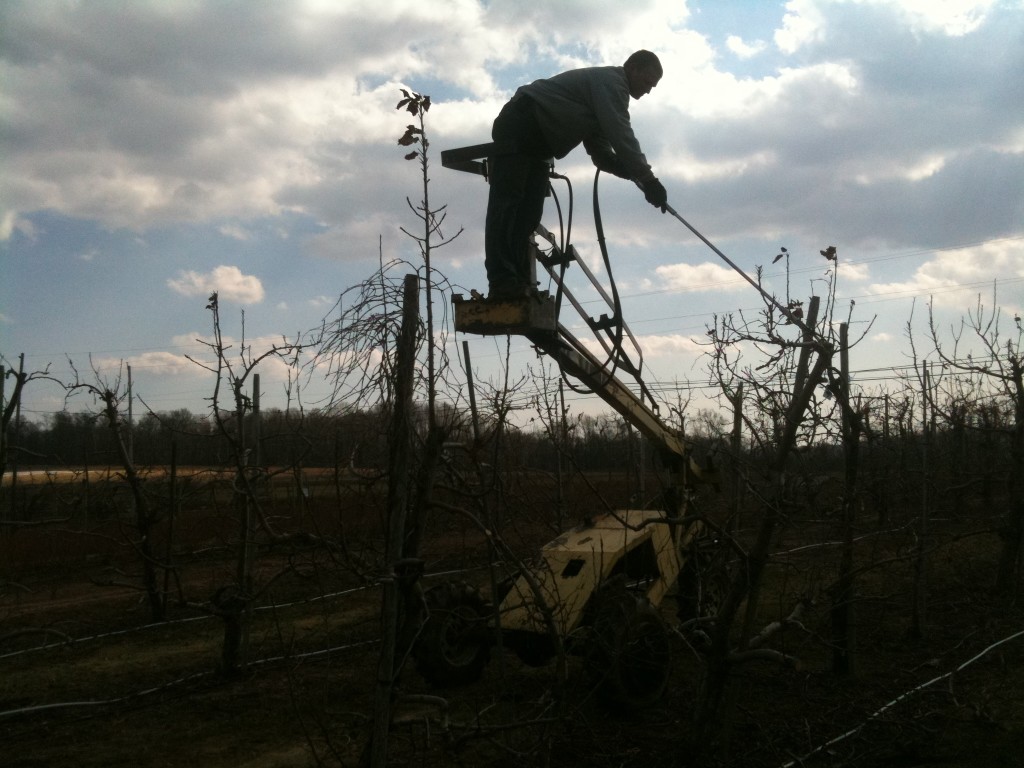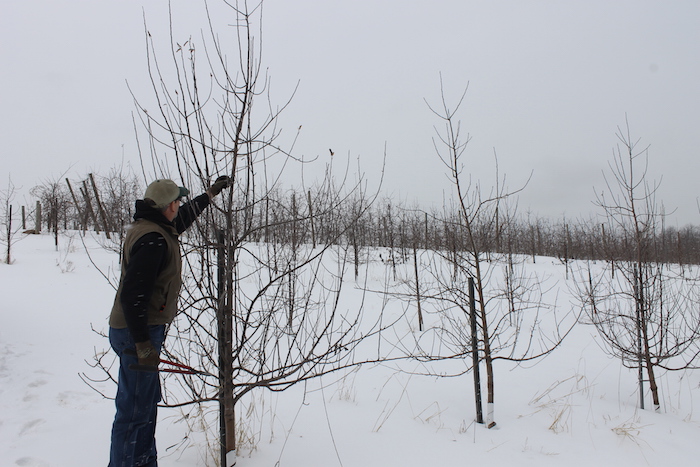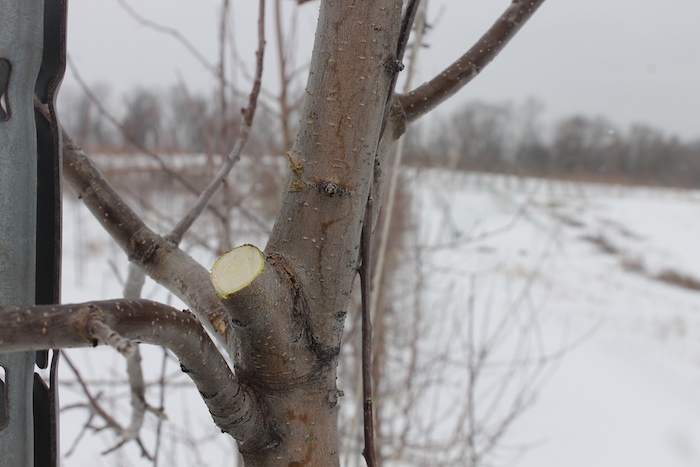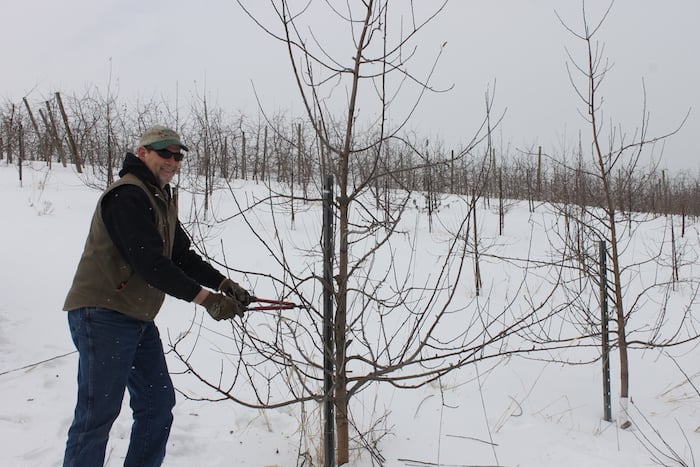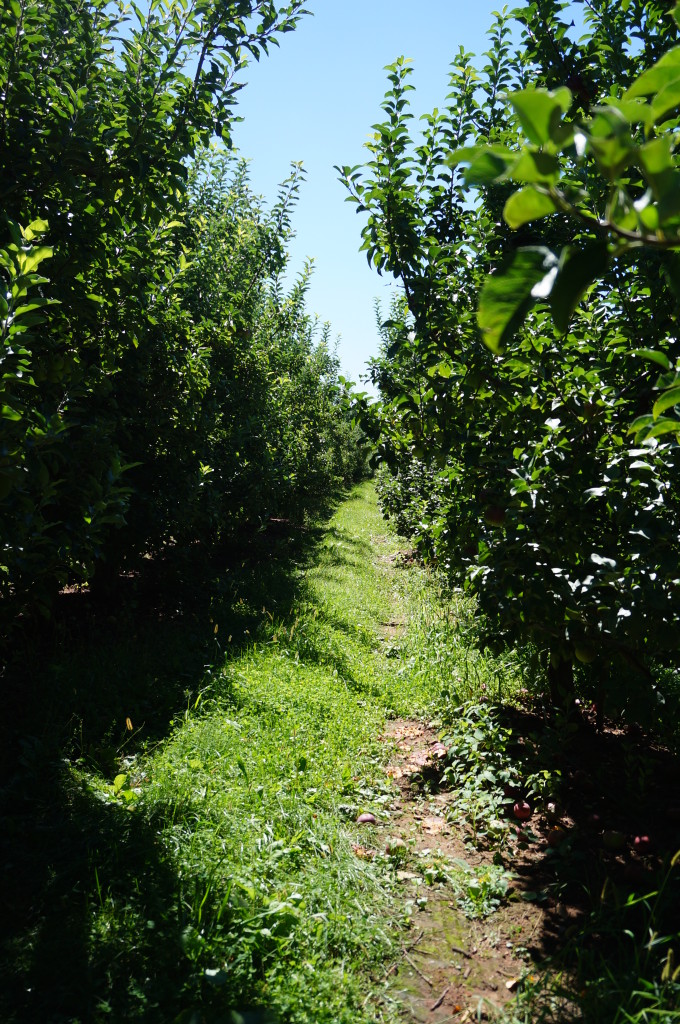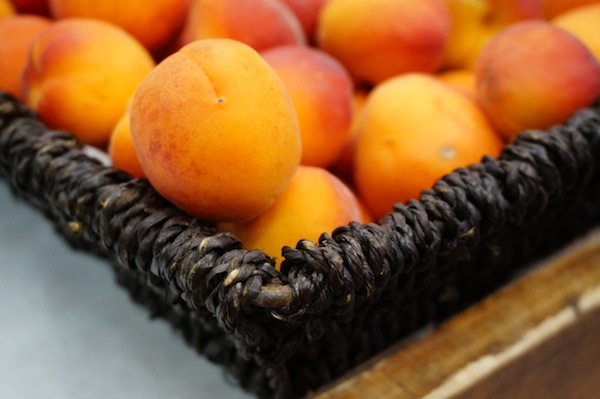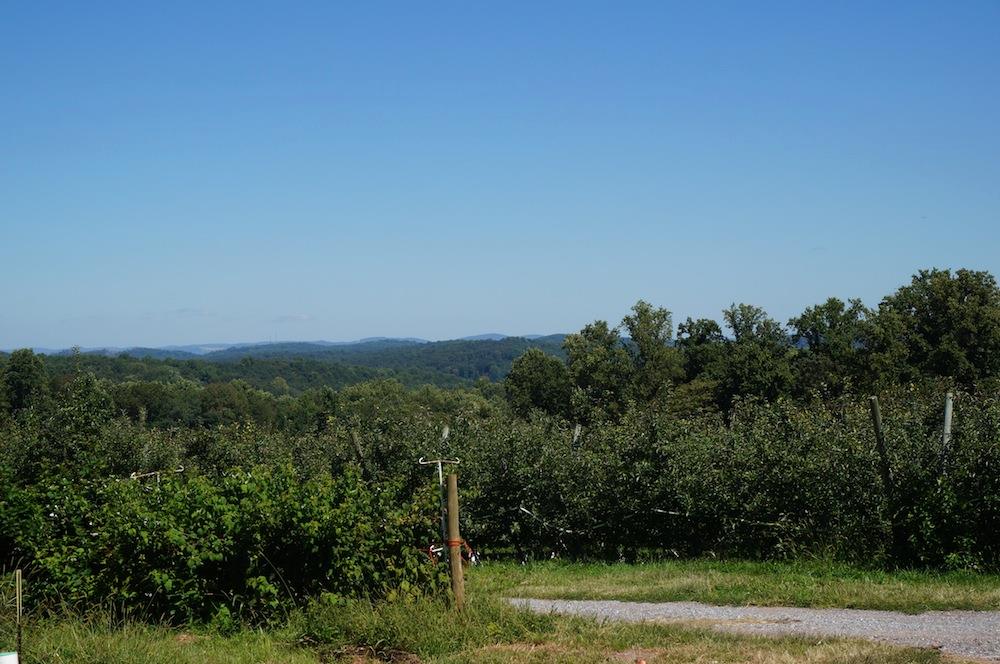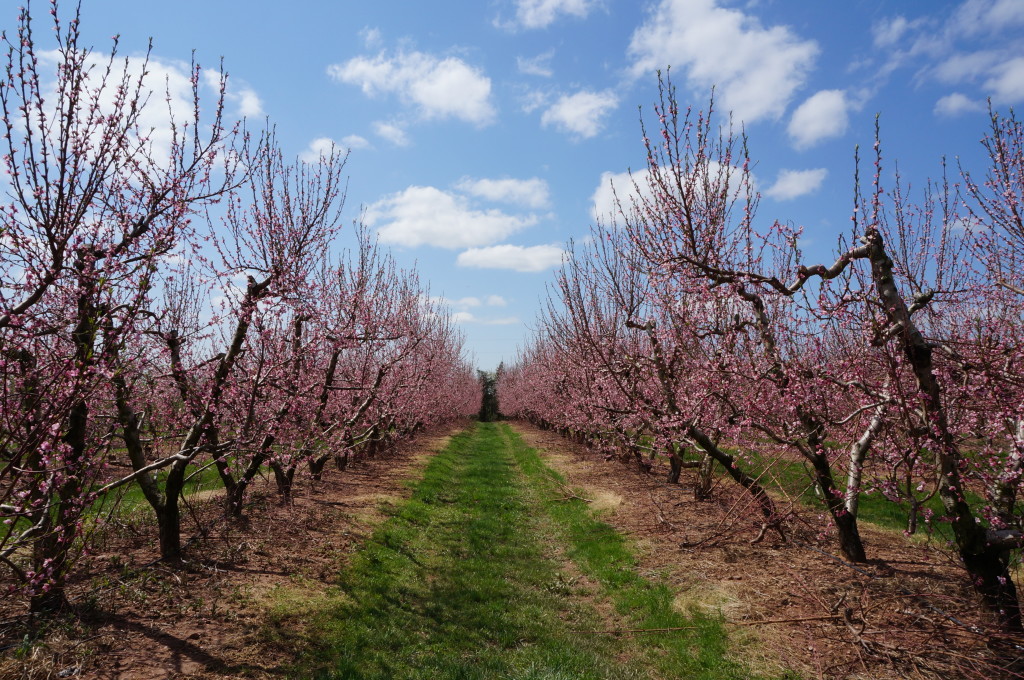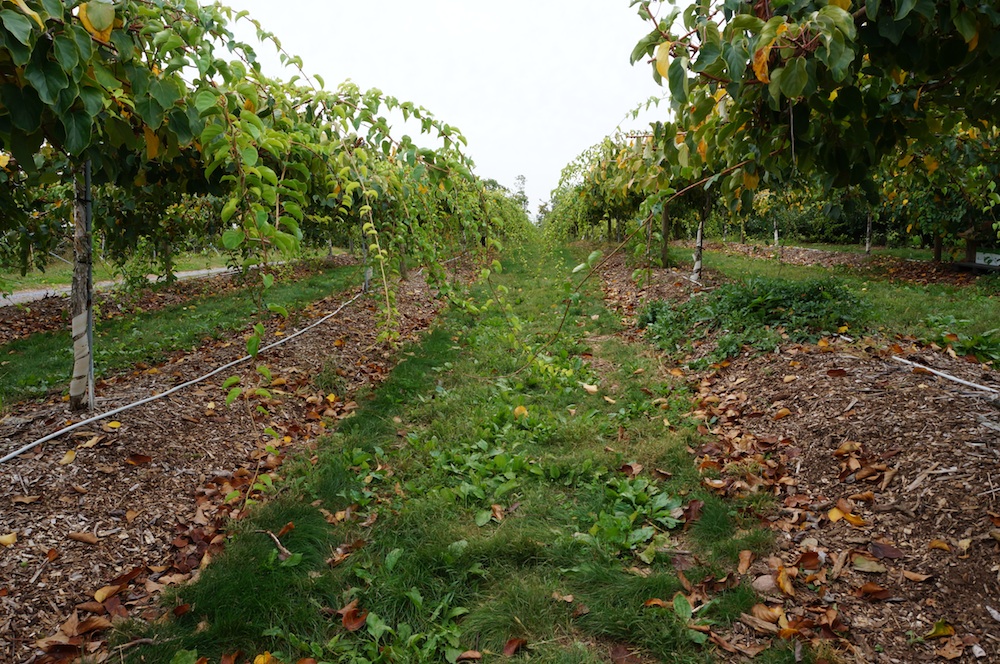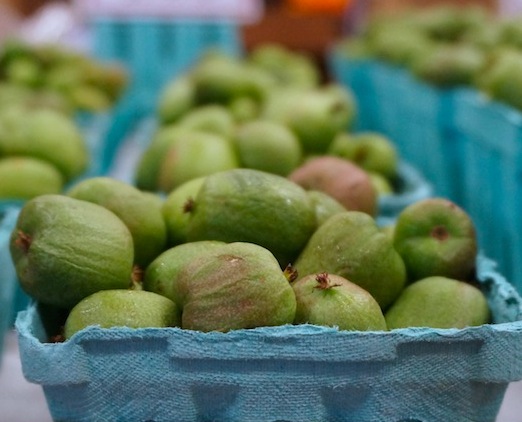This week, I talked with Ed Weaver to discuss the many questions customers ask about pruning. Many home gardeners have asked us to share our pruning tips and expertise, so this article attempts to answer most of our frequently asked questions. Before digging into the questions, though, Ed and I chatted for a few minutes about the bitter cold winter that they are experiencing and how that affects crops. Thankfully, so far the crops are okay. As we discussed pruning, Ed noted pruning precautions for cold winters like this one.
What are some of the tasks on your to-do list for the orchard in the winter, especially in light of this cold winter?
The orchard staff of about 6-8 men spends close to 3,000 hours between mid-December and April pruning their 90 acres of fruit trees and berries. We’re careful on what pruning we do before a cold snap. Older trees are more hardy and can withstand drops in temperature more than younger trees can. We don’t do much if it’s below zero. Consistently cold temperatures are okay for our fruit trees because they are well into dormancy by now. If the temperatures drop to -10, then we may start to be concerned. Temperatures in the single digits and teens for weeks at a time are better for the trees than if it were to warm up and then drop significantly.
In addition to pruning, they set out mouse and vole bait in orchard, cut firewood from trees that were removed, plan for spring plantings, install trellises and irrigation systems, spread fertilizer and perform other maintenance tasks.
When do you start pruning different fruit trees? Why do you start with some sooner than others?
We start in early December in this order: caneberries [red and black raspberries and blackberries], apples and pears, peaches and nectarines, blueberries, cherries, apricots. We start with the more hardy plants and move to the more delicate ones. When it warms up more, the sap flows during the day and this helps heal the cuts better.
At this point, in late February, they have nearly completed apples and pears and will soon begin on stone fruit, blueberries and cherries.
Does every fruit tree need to be pruned every year?
It is best to do it every year. If you wait two years then excessive pruning is needed, which encourages vegetative growth rather than fruiting wood growth. Pruning every year helps keep the tree in balance.
What do you do if a tree hasn’t been pruned in several years?
If a tree has not been pruned in several years it is best to not prune too excessively that year but do it in stages over several years.
Ed mentioned that, with strategic pruning over a few years, he helped a friend save an apple tree that hadn’t been pruned in 8 years. However, regular pruning is the best way to keep a tree healthy.
Do you need to apply a wax for larger cuts?
Wax (or tree paint) can be used if cuts are larger than four inches.
What do you do with the trimmings from the trees?
Prunings 1 ½ inch or smaller are shredded using a flail chopper. These chips provide great organic matter for the soil. Larger prunings, along with firewood from trees removed, are cut and used for smoking, fireplace wood, etc.
Ed noted that they may sell more wood trimmings if the demand is higher for orchard applewood and cherry wood for smoking meat.
What tools do you use to prune a tree?
We use a variety of tools including a pole saw for larger cuts, 18 – 36 inch hand loppers, air powered loppers, or small hand pruners for fine pruning (less than ½ inch).
Where can someone learn how to prune?
Penn State Agriculture Extension Center is a great resource with many educational resources on how to prune your fruit trees and berries.
Also, take a look at our pruning videos linked in this article.
What causes fruit to drop off trees before it’s ripe?
This can be caused by nutritional deficiencies, insect or disease issues. This is a good article talking about premature fruit drop.
Ed noted that other conditions may be out of your control, such as wind, overproduction or low irrigation. Fruit trees need an adequate amount of water to thrive. Even in our humid East Coast climate, the trees at Weaver’s Orchard are irrigated.
What are the best ways that a casual gardener can keep their fruit trees healthy and productive?
Pay attention to soil nutrition, provide adequate moisture and prune annually. One of the most critical, effective sprays is a well-timed horticultural oil spray early in the spring about the time the leaf buds are fully swollen and ready to break forth with their leaves. It can be applied just before the leaves come out, and up until the leaves are half an inch long.
What do you do if your tree shows signs of mold or fungus growing on it?
Once you see it is often too late. This often happens in the last six weeks of maturity. It’s best to spray preventive fungicide (often organic) than try to remedy later using excessive sprays.
Ed noted that one of their main defenses against bacteria is a copper spray, which is an organically approved fungicide. He mentioned that they generally apply copper to all stone fruit, apples, pears and cherries early in the season before the leaves start growing. They intently watch weather patterns to make sure they only apply what is necessary for particular weather challenges of the given season.
In Pennsylvania, our annual rainfall average is 40 inches, whereas the locations where they grow most fruit on the West Coast only receive 8-10 inches of rain per year. This provides different challenges for fruit growers on each coast, leading East Coast fruit farmers to need to use more materials to guard against the spread of bacteria and fungus growth in their warm and wet climate where these organisms thrive. Justin Weaver answered many questions about the use of fungicides in this article we interviewed him for a few years ago.
I often hear that people who grow plums or apricots don’t have a crop every year. Is that common? Is that related to weather conditions, or to improper care?
Plums and apricots are usually the first fruit trees to bloom, making them most susceptible to early freezes or frosts. So it is somewhat common and mostly related to weather.
What is the easiest tree fruit to grow, and the most difficult given our climate?
I would say the easiest is apples and the most difficult are cherries and apricots.
When do you plant various crops such as asparagus, strawberries and fruit trees?
95% of our fruit is planted in the spring. If we plant in the fall, we’d have to plant in late October or early November.
All fruit trees are planted in the spring: late March through April at Weaver’s. You can plant in the fall which gives them a half year head start, but that leaves them more vulnerable to winter damage.
Asparagus, blueberries and all caneberries are usually planted in April.
Bare root strawberries are planted in May of the previous year, and plug plant strawberries (which look just like the vegetable plants you might plant in your garden) are planted in late August.
The strawberries planted in May will begin to blossom in July, but they prune off the blossoms to allow the plant to focus on producing the plant. Both would be ready for harvest the next May. The Chandler variety of strawberries do best when planted as a plug plant.
When is peak bloom expected at the orchard this year?
Plums and apricots will start the first week April.
Cherries and pears will start in mid April.
Apples will peak around April 25 through May 8.
Customers will be happy to note that the apricot and plum blossom dates should coincide nicely with the orchard’s Easter Egg Hunts slated for April 3rd and 4th.
What care is required for Kiwi berries?
Kiwi berries always have vigorous growth so they get pruned about three times from April to July. They do not require much care with insects or disease, primarily just a late season fungicide for sooty blotch disease. Stinkbugs and Spotted Wing Drosophila, our two most pestilent insects are some of the only insects that are a concern for the kiwi berries. Several home gardeners have complained that they planted kiwi berries and found that they took over their garden or backyard.
Ed noted that Weaver’s was advised to plant kiwiberries 18-20 feet apart. They thought this advice seemed a little excessive, but followed it anyway. They were very thankful to have done this! After just two years, the kiwiberry vines have completely filled in their trellises.
Do you have any other FAQ’s people ask or advice that you can help address here?
Yes, here are some general rules on pruning:
Apples/Pears: Few larger cuts are better than many small cuts. Prune for light – to allow more light into tree.
Peaches/Plums/Apricots/Nectarines: We often go through peaches two times. First we go through during the late dormant period, in March, making any necessary larger cuts. The second time through making small cuts, leaving twigs that are about the diameter of a pencil and cutting off weaker wood. Also we cut back each shoot to about 12-18 inches depending on number of fruit.
Cherries: A little more complex. Click here for a great video on pruning cherry trees. Prune out weak and pendant wood. Prune out any dead wood. Make several renewal cuts. Prune out a few largest branches leave a stub 8- 15 inches long. Tip remaining branches by 3-6 inches stimulate new growth.

